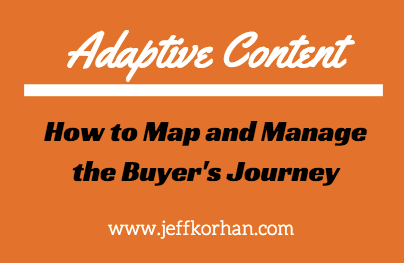Podcast: Play in new window | Download
Subscribe: RSS

This is Episode 44 of This Old New Business weekly business podcast with Jeff Korhan.
If you are not familiar with the term, adaptive content is generally described as content that meets the buyer when and where they are. This is often described as having available the right content, in the right place, and at the right time.
In other words, your content needs to be integrated across multiple channels and devices. While this may seem idealistic, it is indeed possible if you make the effort to map out your buyer’s journey and continuously make experience-based adjustments.
If you really care about being the best in your market and serving your customers well, I’m confident you’ll really enjoy this one-on-one episode with me. If social media and content marketing feels somewhat aimless or random to you at times, then I know you’ll enjoy this conversation.
Adaptive Content Adds Value at Every Touchpoint
For discussion purposes, I’ve organized the buyers journey into three phases, before, during and after the sales transaction.
Phase I – The Audition: Getting Buyers to Know Your Business
Phase II – Collaborative Engagement: Showing Buyers They Will Enjoy Working with You
Phase III – Relationship Validation: Earning the Ongoing Trust of Your Buyers
It’s important for the business to map out each of these phases to fully understand what their buyers are thinking, feeling, doing and seeing. There is a simple tool known as an Empathy Map for accomplishing this. Download this version of The Empathy Map here.

The Empathy Map by Copyblogger
Buyers have different thoughts, feelings and needs at different phases throughout their journey with your business, and will indeed choose the business that seems to understand them, their challenges and their worldview. In a word, the winning company is the one that is empathetic.
Most marketers place the greatest emphasis on customer acquistion. That audition is the traditional role of marketing and sales. This preview takes a buyer that is uncertain but interested and attempts to convert him or her into a customer.
The conversion process for many businesses is the collaborative engagement phase. This is when the buyer has made an initial commitment and now wants to be cared for, and ideally wowed. Therefore, it’s vital for buyers to completely understand how your business process works and why.
The most important phase of the buyers journey is after they have made the purchase. This is the opportunity to add value to the product or service solution by providing useful education for using it well. This content may be free or premium content as a subscription, or free or premium access to a private user community.
What Happens Next?
Content that adapts to buyers and their circumstances must answer the one question that is on everyone’s mind, and that is: What’s next?
The reason most buyers do not buy is they do not understand. It’s up to the marketer to map out the journey to address every possible inquiry, and more important, to adapt to recent feedback and changing market conditions.
When you make the shift from a traditional sales process to the more contextual buyers journey, amazing things happen. There is a clear understanding of what should happen next that can create a collaborative dance that leads to even better outcomes than anyone had expected.
I’d love to hear your thoughts on adaptive content? Meet me over on Twitter to take the conversation further.
How to subscribe to This Old New Business podcast
Click here to subscribe via iTunes.
You can also subscribe via Stitcher.
Help us Spread the Word
If you enjoyed this episode of This Old New Marketing podcast, please head over to iTunes or Stitcher to leave a rating, write a review, or subscribe.
About the Author: Jeff Korhan, MBA, is the author of Built-In Social: Essential Social Marketing Practices for Every Small Business and host of This Old New Business podcast.
He helps mainstream businesses adapt their traditional growth practices to a digital world. Connect with Jeff on LinkedIn, Twitter, Facebook, and Google+



